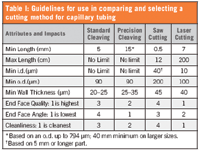Advances in Cutting and Cleaving of Fused Silica Capillary Tubing
Polymicro Technologies, a subsidiary of Molex Inc.
Polyimide coated fused silica capillary tubing is frequently employed in a variety of analytical instrumentation. In this application note we revisit methods for cutting and cleaving capillary tubing with a focus on recent advances.
Fused silica capillary tubing's unique properties have made it a key component in separation scientist's tool box. Although used in analytical techniques such as GC, CE, capillary LC, CEC, and cytometry, it is of increasing importance in the area of fluid metering such as in drug delivery systems. Its dimensional precision is unmatched for microfluidic interfacing and mass flow control. The easy of cutting capillary to length is a key attribute, but care must be taken to insure that the appropriate cutting or cleaving method is selected so that optimum system performance is achieved.
Previous publications have outlined and defined the four primary methods of end face preparation, with those being standard cleaving, precision cleaving, laser cutting, and saw cutting (1,2). Subsequent work provided more detailed guidance on selecting the most optimum method (3). In this latter effort tubing attributes such as i.d., o.d. and wall thickness were considered, as were there influence on finished part length. A comparative analysis of end-face quality, perpendicularity, and cleanliness of the different techniques was also made. Advances in cutting and cleaving methods have been realized and are discussed in this note.
Recent Advances
Standard Cleaving — Cleaving capillary tubing to lengths less than 20 mm while maintaining a good end face had been challenging at the production level. Improvements in technique now allow standard cleaving to lengths as short as 5 mm on nearly all tubing products.
Precision Cleaving — This increasingly popular technique has seen similar reductions in finished part length due to tooling advances. Lengths as short as 15 mm are now achievable. This applies to tubing with a high glass cross sectional area such as our new 1/32" OD Capillary. Polymicro has also developed the ability to provide precision cleaved parts with up to 35 mm of the polyimide removed from the cleaved end. Previously, parts with this length of polyimide removed would have required a laser cut or lower quality standard cleave.
Saw Cutting — The maximum part length for saw cutting has increased from 4.5 cm to 12 cm due to investments in state of the art sawing equipment. New cleaning techniques allow for processing of tubing with i.d. down to 40 µm. As in the past, part length is limited when saw cutting small i.d. tubing. Likewise, the minimum o.d. that can be processed has been lowered. For short parts, the o.d. can be as low as 200 µm.
Laser Cutting — Industry leading attributes previously listed for laser cutting remain unchanged. However, related advances realized include improved control of end face contour of thick wall parts. Further, developments in the associated laser based polyimide removal techniques and equipment now allow for ablation of longer lengths of polyimide, i.e. up to 40 mm on most tubing products.
Table I summarizes the current guidelines for use in selecting the most appropriate cutting and cleaving method for your application.

Table I: Guidelines for use in comparing and selecting a cutting method for capillary tubing
Conclusion
This note reviewed recent advances in the primary techniques employed for cutting and cleaving capillary tubing. For assistance with your specific application please contact a Polymicro Technical Sales Specialist.
References
(1) "Cutting and Cleaving Capabilities", The Book on the Technologies of Polymicro, Polymicro Technologies Publication (2011), pp. 3–5.
(2) J. Macomber, R. Hintz, T. Ewing, and R. Acuna, LCGC Application Notebook, June 2005, p. 81.
(3) J. Macomber, P. Lui, and R. Acuna, LCGC Application Notebook, Sept. 2009, p. 66.
Polymicro Technologies, a subsidiary of Molex Inc.
18019 N. 25th Ave., Phoenix, AZ 85023
tel. (602) 375-4100
Website: www.polymicro.com

Analysis of Greenhouse Gases by Gas Chromatography
May 15th 2024This application note demonstrates the use of SCION's 8500GC system for the analysis of key greenhouse gases—carbon dioxide, methane, and nitrous oxide—in a single atmospheric air matrix. Highlighting the system's excellent sensitivity and repeatability, this method is crucial for understanding emission sources and combating climate change.
Analysis of DEHP in Drinking Water by HPLC-DAD
May 15th 2024This application note outlines a method for detecting low levels of 1,4-Dioxane, a likely carcinogenic compound, in drinking water using SCION GC-MS technology. It details the procedure for analyzing water samples spiked with 1,4-Dioxane, achieving excellent sensitivity and low detection limits, demonstrating the method's effectiveness for environmental monitoring.
Plant Protection Product Impurity Screening by GC-FID with GC-MS Confirmation
May 15th 2024This application note from SCION Instruments delves into the meticulous screening of impurities in plant protection products using GC-FID, with GC-MS for confirmation. It emphasizes the necessity of identifying and quantifying impurities to comply with regulatory standards in industries such as pharmaceuticals, food, and agriculture. The study specifically examines eugenol, showcasing how to determine significant impurities for regulatory submission. The approach integrates GC-MS and analytical standards, ensuring precise impurity identification and quantification critical for product approval.